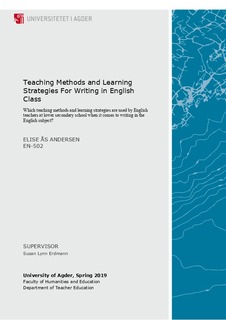| dc.description.abstract | English is a subject in Norwegian lower secondary schools where the students learn how to write in English. This L2 learning process can be complex,and those who teach English faceseveral challenges connected to developing successful L2 writers. For example challenges connectedto enhancing, facilitating and nurturing the learning process(Fenner & Skulstad, 2018, p.139). Because of the complexity of writing, it might be useful for teachers to know different writing strategies that are effective and useful for L2 learners. This research studies which teaching methods and learning strategies are used by English teachers at lower secondary school in Norway, when it comes to teaching writing in English. Norwegian and internationalresearchhas shownthat writing is an essential, basic skill. A writing process consists of four phases: the pre-writing phase (planification), the start-up phase, the revision phase and the finalizing phase. There are different writing strategies suitable for all four phases (Skrivesenteret, 2013). ESL (English as a second language) writers are individuals, which means that English teachers need to know their students’ needs, strengths and weaknesses. Any givenmethod orstrategymight not be suitable for all ESL students. For example, according to Elvebakk and Jøsok (2017) and Horverak(2016), the five-paragraph essay is too difficult for some students, while it is very effective for others. The current study is a mixed method study, the qualitative part relying on interviews while the quantitative part relying in data collected from a questionnaire. The findings demonstratethat English teachers in Norway at lower secondary school, are confused on terminology regarding methods and strategies. However, teaching from theblackboard, ICT, independent study, theme-work, in-depth assignments, writing assignments and “learning together” are methods used by the informants and 47,8-92,2% of therespondents. Strategiessuch asmind-map, friend-diagram, VØL-sheet, speed-writing and free-writing are mentioned by both the informants and the respondents. Hence, Norwegian English teachers at lower secondary schools use different methods and writing strategies when teaching English.However, furthereducation on teaching methods for Norwegian English teachers seems to be desired, supported by results from the current study and a study conducted by Klewe et al. (Klewe, Berg, Neset & Sørlie, 2013, p.35). | nb_NO |

